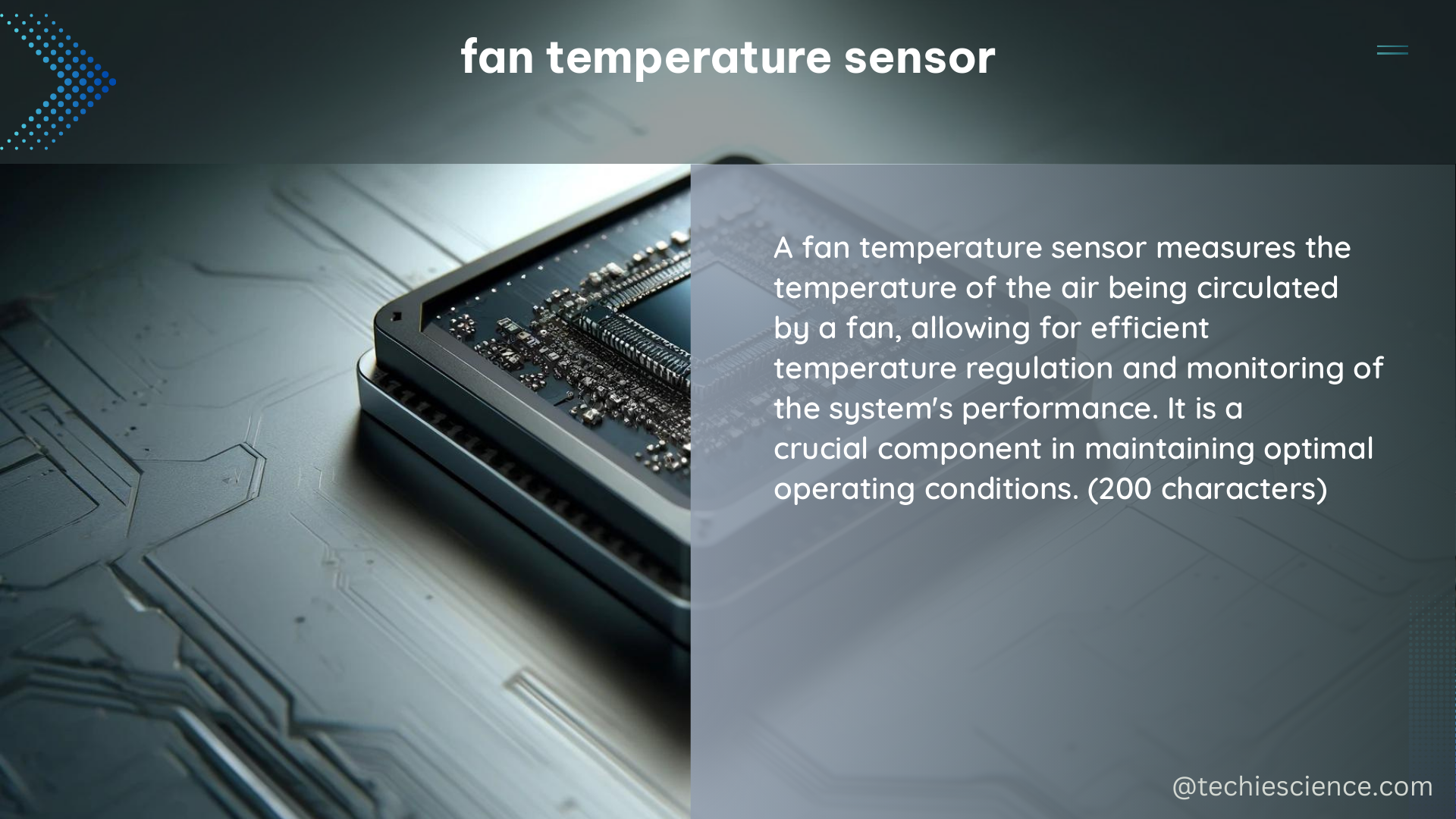The fan temperature sensor is a critical component in electronic systems, particularly in computers, servers, and other high-performance devices. It measures the temperature of the airflow or the surrounding environment to regulate the fan speed, ensuring optimal cooling and preventing overheating. This comprehensive guide delves into the technical specifications, installation, and calibration of fan temperature sensors, providing a valuable resource for DIY enthusiasts and professionals alike.
Understanding the Technical Specifications of Fan Temperature Sensors
Fan temperature sensors are designed to operate within a specific temperature range, typically between -40°C to +125°C. The accuracy of these sensors can vary, with some models offering ±2°C to ±5°C precision, depending on the manufacturer and the intended application.
The response time of a fan temperature sensor is a crucial factor, as it determines how quickly the sensor can detect and respond to changes in temperature. High-performance sensors can have a response time in the order of milliseconds, allowing for rapid adjustments to fan speed and ensuring effective cooling.
Sensitivity is another important specification, as it determines the smallest temperature change that the sensor can detect. Commonly, fan temperature sensors have a sensitivity range of 0.1°C to 1°C, enabling precise temperature monitoring and control.
Table 1: Typical Technical Specifications of Fan Temperature Sensors
| Specification | Range |
|---|---|
| Temperature Range | -40°C to +125°C |
| Accuracy | ±2°C to ±5°C |
| Response Time | Milliseconds |
| Sensitivity | 0.1°C to 1°C |
Sensor Installation and Calibration

Proper installation of the fan temperature sensor is essential for accurate temperature measurement. The sensor should be positioned in a location that accurately represents the airflow or the surrounding environment, avoiding areas with potential hot spots or turbulence.
Calibration is another crucial step in ensuring the reliability of the fan temperature sensor. Calibration involves exposing the sensor to known temperature references and adjusting its output accordingly. This process compensates for any manufacturing variations or drifts over time, ensuring that the sensor provides accurate and consistent temperature readings.
The calibration process typically involves the following steps:
- Identify the sensor’s calibration points or adjustment mechanisms, which may be accessible through software or physical adjustments.
- Expose the sensor to a known temperature reference, such as a calibrated temperature bath or a stable temperature environment.
- Compare the sensor’s output with the known temperature reference and calculate the necessary adjustments.
- Apply the adjustments to the sensor’s calibration points or settings, ensuring that the sensor’s output matches the known temperature reference.
- Repeat the calibration process at multiple temperature points to ensure the sensor’s accuracy across its entire operating range.
Regular calibration is recommended to maintain the sensor’s accuracy and reliability over time, as environmental factors and aging can cause the sensor’s performance to drift.
Advanced Sensor Technologies and Applications
Fan temperature sensors are not limited to traditional thermistor-based designs. Advancements in sensor technology have led to the development of more sophisticated solutions, such as:
- Thermocouple-based Sensors: Thermocouple-based fan temperature sensors offer a wider temperature range, higher accuracy, and improved stability compared to thermistor-based designs.
- Resistance Temperature Detectors (RTDs): RTD-based fan temperature sensors provide excellent accuracy, linearity, and long-term stability, making them suitable for critical applications.
- Infrared (IR) Sensors: Infrared fan temperature sensors can measure the surface temperature of components without direct contact, enabling non-invasive monitoring and improved safety.
These advanced sensor technologies find applications in a variety of industries, including:
- Computer and Server Cooling: Precise temperature monitoring and fan speed control are essential for maintaining optimal cooling in high-performance computing environments.
- Industrial Automation: Fan temperature sensors are used to monitor and regulate the cooling of motors, drives, and other industrial equipment.
- Automotive Systems: Fan temperature sensors play a crucial role in engine cooling systems, ensuring efficient thermal management and preventing overheating.
- HVAC Systems: Temperature sensors are integrated into HVAC systems to monitor and control the airflow and temperature in buildings, ensuring occupant comfort and energy efficiency.
Conclusion
Fan temperature sensors are a vital component in electronic systems, providing the necessary data for effective temperature regulation and cooling. By understanding the technical specifications, installation requirements, and calibration procedures, DIY enthusiasts and professionals can ensure the reliable and accurate performance of these sensors in their applications.
This comprehensive guide has covered the key aspects of fan temperature sensors, from temperature ranges and response times to advanced sensor technologies and their diverse applications. By mastering the intricacies of fan temperature sensors, you can optimize the cooling performance of your electronic systems, enhance energy efficiency, and maintain the overall health and longevity of your devices.
References
- Motion Activated Temperature Controlled Electric Fan
- Temperature, Power & Fan Data
- FanControl USB Temperature Sensor Plugin
- How to Subtract Temperature Effects from Sensor Data
- Thermal Management of Electronic Systems

The lambdageeks.com Core SME Team is a group of experienced subject matter experts from diverse scientific and technical fields including Physics, Chemistry, Technology,Electronics & Electrical Engineering, Automotive, Mechanical Engineering. Our team collaborates to create high-quality, well-researched articles on a wide range of science and technology topics for the lambdageeks.com website.
All Our Senior SME are having more than 7 Years of experience in the respective fields . They are either Working Industry Professionals or assocaited With different Universities. Refer Our Authors Page to get to know About our Core SMEs.